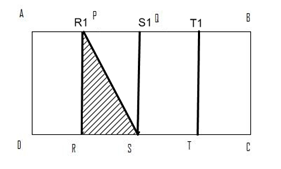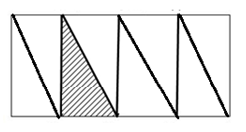Exams > Cat > Quantitaitve Aptitude
QUANTITAITVE APTITUDE CLUBBED MCQs
Total Questions : 1394
| Page 3 of 140 pages
Answer: Option D. -> 17
:
D
Let the number be 10x + y.
Then, 1≤x≤9,0,≤y≤9 and x2+y2=10k.
xx2y2mustendinPossiblevalueofy1193,72464,63911,941642,85255563642,874911,986464,698193,7
The required number = 17, hence option (d).
:
D
Let the number be 10x + y.
Then, 1≤x≤9,0,≤y≤9 and x2+y2=10k.
xx2y2mustendinPossiblevalueofy1193,72464,63911,941642,85255563642,874911,986464,698193,7
The required number = 17, hence option (d).
Answer: Option C. -> 9
:
C
The question is based on the last non-zero digit (i.e. remainder when the number is divided by 10), as when x is maximum, 10x will cancel out all the zeroes in the end.
It now becomes a question based on the rightmost non-zero integer in 72730 (302780 will end with more zeroes).
72730⟹2730=4K+2
Thus, the rightmost non-zero integer is 9.
:
C
The question is based on the last non-zero digit (i.e. remainder when the number is divided by 10), as when x is maximum, 10x will cancel out all the zeroes in the end.
It now becomes a question based on the rightmost non-zero integer in 72730 (302780 will end with more zeroes).
72730⟹2730=4K+2
Thus, the rightmost non-zero integer is 9.
:
Reflection of the functionf(x) = (x+1)3 about the line x=3 is going to be g(x) =(x - 7)3. g(x) is the translation of f(x) 4 units to the right of x=3. h(x) being the reflection of g(x) about the x-axis is going to be -(x - 7)3 So the value of h(x) at x=8 will be -(8 - 7)3 = -1.
Answer: Option A. -> 20
:
A
Let ∠ACD = ∠BAC = x. Connect D to B such that the line intersects AC at O.

As the quadrilateral ABCD is cyclic, ∠AOD = 2 * ∠ACD. (Because O is the centre of the circle around the cyclic quadrilateral, and angle subtended at center is twice the angle subtended at a point on the circumference by the same arc AD, here.
So, ∠AOD = 2x
∠EBA = ∠BED = 30
∠BDC = ∠DBE + 30
∠AOD is exterior angle for triangle COD.
So, ∠AOD = 2x = 30 + ∠DBE + x
∠x = 30 + ∠DBE.
So, ∠BAC can't be less than 30 degrees so 'a' is the answer.
:
A
Let ∠ACD = ∠BAC = x. Connect D to B such that the line intersects AC at O.
As the quadrilateral ABCD is cyclic, ∠AOD = 2 * ∠ACD. (Because O is the centre of the circle around the cyclic quadrilateral, and angle subtended at center is twice the angle subtended at a point on the circumference by the same arc AD, here.
So, ∠AOD = 2x
∠EBA = ∠BED = 30
∠BDC = ∠DBE + 30
∠AOD is exterior angle for triangle COD.
So, ∠AOD = 2x = 30 + ∠DBE + x
∠x = 30 + ∠DBE.
So, ∠BAC can't be less than 30 degrees so 'a' is the answer.
Answer: Option A. -> 1.41
:
A
Go from answer options
If x =1.41 =√2 then we get
√2√2√2√2√2=4
Hence the equation is satisfied.
:
A
Go from answer options
If x =1.41 =√2 then we get
√2√2√2√2√2=4
Hence the equation is satisfied.
Answer: Option C. -> A8
:
C
We know that the area of all triangles between two parallel lines and having a common base is the same
Thus, the triangle can also be represented as follows

we can say that, area (RQS) = area (RR1S)
Using the concept of graphical division, we can divide the figure into 8 equal regions as follows.

The required region is A8 units.
:
C
We know that the area of all triangles between two parallel lines and having a common base is the same
Thus, the triangle can also be represented as follows

we can say that, area (RQS) = area (RR1S)
Using the concept of graphical division, we can divide the figure into 8 equal regions as follows.

The required region is A8 units.
Answer: Option B. -> 24
:
B
Let the area of the square= s, the area of the circle= c, and the area of the overlapping portion= x. The area of the circle not overlapped by the square is "c -x” and the area of the square not overlapped by the circle is "s - x”, so the difference between these two is (c -x) -(s -x) = c -s = 9π2-4 .(approximately = 24.26). Hence the correct answer is option (b).
:
B
Let the area of the square= s, the area of the circle= c, and the area of the overlapping portion= x. The area of the circle not overlapped by the square is "c -x” and the area of the square not overlapped by the circle is "s - x”, so the difference between these two is (c -x) -(s -x) = c -s = 9π2-4 .(approximately = 24.26). Hence the correct answer is option (b).
Answer: Option B. -> 48
:
B
The digits of N can be 2, 4, 6 and 8. Since N is divisible by 4, the last two digits must be 24 or 28 or 44 or 48 or 64 or 68 or 84 or 88.
When the last two digits are the same, i.e., 44 or 88, there can be no more repetition; then, the first three digits can be chosen in 3! Ways. Thus, the number of possibilities = 3! x 2 = 12.
When the last two digits are distinct, we get the following cases:
i] Third digit is same as fourth digit.
Number of ways remaining two digits can be chosen = 2!
Ii] Third digit is same as second digit.
Number of ways = 2!
iii] Second digit is same as first digit.
Number of ways = 2!
Thus, when the number ends with 24, the number of possibilities = 2! + 2! + 2! = 6.
Since there are 6 cases where the last two digits are distinct, the total number of ways =
6 × 6+ 12 = 36 + 12 = 48. Hence, [b].
:
B
The digits of N can be 2, 4, 6 and 8. Since N is divisible by 4, the last two digits must be 24 or 28 or 44 or 48 or 64 or 68 or 84 or 88.
When the last two digits are the same, i.e., 44 or 88, there can be no more repetition; then, the first three digits can be chosen in 3! Ways. Thus, the number of possibilities = 3! x 2 = 12.
When the last two digits are distinct, we get the following cases:
i] Third digit is same as fourth digit.
Number of ways remaining two digits can be chosen = 2!
Ii] Third digit is same as second digit.
Number of ways = 2!
iii] Second digit is same as first digit.
Number of ways = 2!
Thus, when the number ends with 24, the number of possibilities = 2! + 2! + 2! = 6.
Since there are 6 cases where the last two digits are distinct, the total number of ways =
6 × 6+ 12 = 36 + 12 = 48. Hence, [b].
Answer: Option D. -> 60 cm2
:
D
Among all triangles having a specified base and specified perimeter, an isosceles triangle with the specified base has the largest area.
Hence the triangle is isosceles with perimeter 36 cm and base 10 cm.
Each equal side of the triangle -
=36−102=13cm
∴ Height of the triangle
=√132−(102)2.
=√169−25=12cm
∴ Area of the triangle
12×10×12=60cm2.
:
D
Among all triangles having a specified base and specified perimeter, an isosceles triangle with the specified base has the largest area.
Hence the triangle is isosceles with perimeter 36 cm and base 10 cm.
Each equal side of the triangle -
=36−102=13cm
∴ Height of the triangle
=√132−(102)2.
=√169−25=12cm
∴ Area of the triangle
12×10×12=60cm2.

















